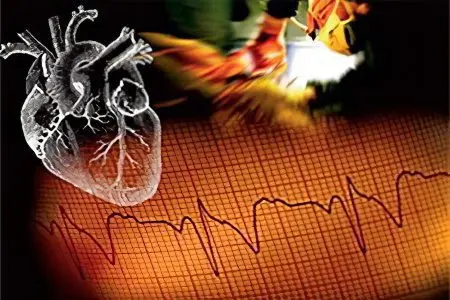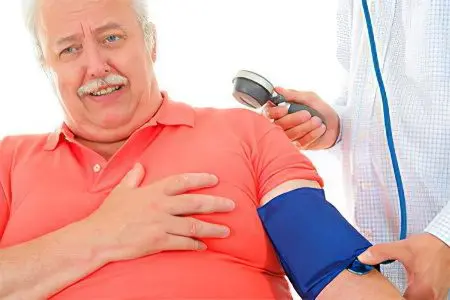Contents
What is a hypertensive crisis?
A hypertensive crisis is a sudden increase in blood pressure, as a result of which a person’s well-being deteriorates sharply. It is very difficult to predict the development of a crisis. For each individual patient, a hypertensive crisis is characterized by an increased level of blood pressure, which differs from the regular one. Even if the measured pressure is considered normal for most people, it may be too high for this person.
What is dangerous hypertensive crisis?
A hypertensive crisis is dangerous because it causes serious complications – vital organs are affected: the liver, kidneys, heart and brain. In addition, a hypertensive crisis can lead to visual impairment. Therefore, when symptoms of a crisis appear, it is important to provide timely and high-quality assistance. It is to eliminate the symptoms and prevent the occurrence of complications. Drugs that allow you to quickly restore normal blood pressure should be selected by a qualified specialist. An overdose of drugs or too strong an effect can cause additional problems with the blood supply. In this case, tissues and organs will be deprived of the necessary amount of oxygen.
The doctor selects the drug, taking into account the age of the patient and the characteristics of his body. When assisting with a hypertensive crisis, it is important to accurately calculate the rate of decrease in blood pressure and the optimal level that should be achieved as a result.
Risk Factors

The causes of this condition in humans are:
stress or emotional tension;
change in weather conditions: sharp cooling, warming, winds;
alcohol poisoning;
the use of a large amount of salt;
discontinuation of therapy in those who have been taking antihypertensive drugs for a long time.
However, the most common cause is still nervous strain. Among the main manifestations of a hypertensive crisis is a feeling of fear and anxiety, which must be eliminated first of all in order for the pressure to return to normal.
Types of hypertensive crisis
The crisis is of two types, depending on the severity:
Hypertensive crisis of the first type flows easier and faster. An attack may only last a few hours. At this time, the patient is agitated, suffers from headache, dizziness, and experiences discomfort in the region of the heart. There may be trembling in the body. Of the external signs, the most striking is redness of the skin of the face and neck. In a biochemical analysis of blood during a hypertensive crisis of the first type, an increased number of leukocytes is detected, and in the urine – protein. The pressure rises, the pulse quickens. This type of hypertensive crisis is often called uncomplicated. This means that during an exacerbation of the disease, target organs (brain, heart, kidneys) do not suffer. To cope with the crisis, you need to help the patient during the day. Most often, it is enough to take medications and adhere to bed rest. In an uncomplicated hypertensive crisis, there is no need for hospitalization;
Type II hypertensive crisis continues for several days. The symptoms in this case are the same, however, they are more pronounced. The patient experiences dizziness, heart pain, possible nausea, turning into vomiting, blurred vision. Among the main complications in this case are heart attack, stroke, pulmonary edema. A blood test shows an increase in the erythrocyte sedimentation rate and an increased number of leukocytes. This type of crisis is known as complicated. In most cases, the patient has to be hospitalized, as there is a threat of damage to target organs. Help must be provided immediately, otherwise it will not be possible to avoid serious complications, including death.
Complicated hypertensive crisis usually recurs in the form of periodic attacks. The risk group includes patients suffering from chronic arterial hypertension. To avoid the occurrence of crises, the course of the disease should be monitored. Among patients with hypertension, high mortality due to hypertensive crises was noted.
Epidemiology
In most cases, the call of the emergency medical team is due precisely to a hypertensive crisis. Depending on the region, patients receive treatment of different quality, and the degree of complications also varies. The most favorable situation is in Western Europe. There, the number of cases of hypertensive crisis has decreased due to the high level of development of medicine. It is also associated with high-quality diagnostics, which allows to detect the presence of the disease in time and prevent its exacerbation.
Russia lags far behind in this indicator. Only a quarter of patients receive timely treatment, so cases of hypertensive crisis are much more common. They are more common among women. Men suffer from a hypertensive crisis less frequently. The frequency of exacerbations of the disease is largely due to the imperfect system of medical institutions in Russia and the lack of coordinated work of ambulance teams, polyclinics and inpatient departments.
Symptoms of hypertensive crisis

Symptoms of a hypertensive crisis are:
A sharp increase in blood pressure. It is generally accepted that during a hypertensive crisis, systolic pressure exceeds 150 mm Hg. Art. However, the upper limit of the blood pressure value largely depends on the individual characteristics of the organism, therefore, it should be taken into account what level of pressure is normal for each individual patient. For some, even the “upper” pressure of 130 mm Hg. Art. may become critical;
Headache, which is localized in the back of the head, and dizziness;
Nausea, turning into vomiting – this symptom is more characteristic of a complicated hypertensive crisis;
Vision problems – some patients complain of the appearance of dots before the eyes, partial blindness is possible;
Nystagmus is an involuntary fluctuation of the eyeball. Depending on the direction of movement, nystagmus may be vertical, horizontal, rotational, or pendulum;
Increase in body temperature;
Redness of the skin in the face and neck;
Trembling all over body;
Feelings of fear and panic are common symptoms of a hypertensive crisis, as it is often caused by emotional stress or stress.
First of all, the normal psychological state of the patient must be restored, who, in order to recover, needs to cope with fear and panic, which causes the following symptoms:
increased heart rate and rhythm disturbance, shortness of breath;
sweating;
impaired coordination of movements, unsteady gait.
In accordance with the classification and depending on the symptoms and causes, there are several types of hypertensive crisis:
The first type associated with neurovegetative syndrome. The cause of the crisis in this case is psychological stress, severe stress. Main symptoms: dizziness, nausea, vomiting, headache. All manifestations of this type of hypertensive crisis disappear after a few hours. Hospitalization of the patient is not required, as there is no threat to his life;
The second type hypertensive crisis – water-salt. The renin-angiotensin-aldosterone system in the human body maintains the constancy of the internal environment. When failures occur in her work, a water-salt hypertensive crisis occurs. At the same time, patients experience nausea, headaches, lose their orientation in space, their vision is impaired, including nystagmus. The exacerbation of the disease in this form lasts for several days, and then passes;
Acute hypertensive encephalopathy is considered the most severe type of crisis. In this case, hospitalization of the patient is required, because due to a significant increase in blood pressure, cerebral circulation is disturbed and serious complications develop, for example, convulsions, clouding of consciousness, heart attack or stroke.
Consequences of a hypertensive crisis

The lack of timely medical care in a hypertensive crisis can lead to serious consequences – damage to the kidneys, blood vessels, heart and brain, pulmonary edema, myocardial infarction, angina pectoris. Violations of the activity of the central nervous system often develop, for example, a cerebral stroke or coma.
Dizziness
After a hypertensive crisis, many patients experience difficulties with orientation in space and a sense of the position of their body in it, they feel severe dizziness. It is necessary to consult a doctor to determine the exact cause of this phenomenon.
Perhaps it was not a hypertensive crisis that led to dizziness, but another disease. During an attack, which usually takes you by surprise, you should not panic, sit down and do not close your eyes, but try to focus on something.
If your head hurts…
Headaches are the most common symptom of a hypertensive crisis and one of its possible consequences. The attack passes, but the discomfort in the back of the head remains. In this case, it is required to take medications, which can only be prescribed by the attending physician.
Many drugs that are used in hypertensive crisis are potent, so the dosage must be calculated accurately. During the rehabilitation period after an attack, it is recommended to observe bed rest, which will alleviate the consequences in the form of a headache. However, you should not endure it, you need to contact a specialist who will recommend an anesthetic drug.
Algorithm of actions in case of hypertensive crisis
Before starting the treatment of a hypertensive crisis and using strong drugs, the patient should be helped to cope with the fear and anxiety that inevitably arise in such cases.
To get rid of psychological discomfort allows tincture of valerian, corvalol, motherwort. The patient’s breathing should be even. A few deep breaths and exhalations will help restore it. It is also important to provide fresh air to the room and put the patient on a bed or sit on a chair.
You can reduce the pressure before the arrival of an ambulance with the help of a drug prescribed by your doctor. If the patient experiences severe chest pain, nitroglycerin is used. Pressure should be measured every quarter of an hour. If there is no improvement within a couple of hours, you need to call a doctor.
To provide qualified assistance, the doctor must obtain the most complete information about the nature of the patient’s disease and find out the following:
How long has hypertension developed?
what pressure for the patient is considered increased, and what – reduced;
how long the attack lasts;
whether the patient takes any drugs regularly;
what drugs have been used since the onset of this hypertensive crisis;
whether the patient suffers from chronic diseases, such as diabetes.
The more the doctor knows about the characteristics of the patient’s body, the faster he will be able to provide the necessary assistance. In addition, the specialist must determine the type of hypertensive crisis, depending on which treatment will be prescribed.
The first type – hyperkinetic hypertensive crisis – is associated with an increase in the intensity of the work of the heart, against which there is an increase in systolic blood pressure, at the same time, these processes do not affect diastolic pressure in any way. The patient has profuse sweating, tachycardia. After a few hours, the hypertensive crisis passes.
The second type of crisis is hypokinetic. It manifests itself in changes in both diastolic and systolic blood pressure. A hypertensive crisis lasts for several days, the patient experiences general weakness, reddening of the skin is noticeable, spots appear on it. Target organs are often affected. To choose drugs to help the patient, the emergency doctor must determine the type of hypertensive crisis in accordance with this classification. Medications are administered intravenously or taken orally, depending on whether the hypertensive crisis is complicated or not.
The relief of an uncomplicated hypertensive crisis involves a gradual decrease in blood pressure. In the case of a hyperkinetic crisis, the use of one drug is sufficient; in a hypokinetic crisis, therapy should be complex.









